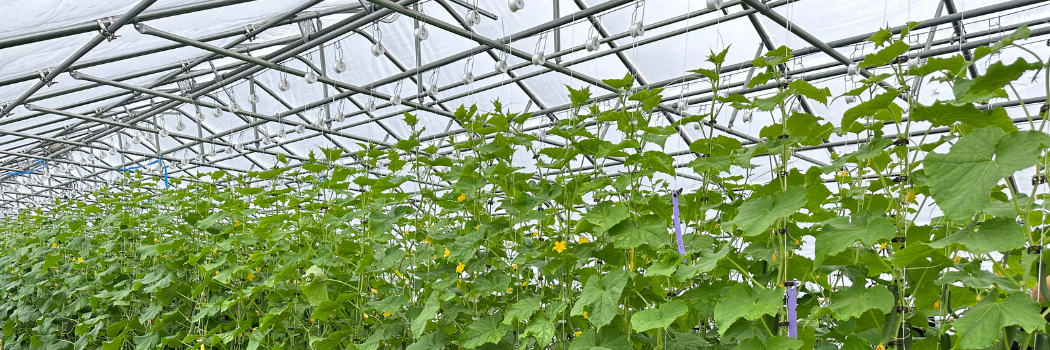- 10 Ways to Extend Your Season with Protected Cultivation
- QuickHoops Gothic High Tunnel Bender | Construction Manual for Modular Moveable Gothic High Tunnel (PDF)
- QuickHoops Gothic High Tunnel Bender | Construction Manual for Stationary Gothic High Tunnel (PDF)
- QuickHoops High Tunnel Bender | Construction Manual for Building a Stationary High Tunnel (PDF)
- QuickHoops Low Tunnel Benders | Instruction Manual (#9377 & #9520) | (PDF)
- Agribon+ AG-19, 30, 50 & 70 Row Cover | Insert (PDF)
- Hitch Mount for QuickHoops Low Tunnel Benders | Instruction Manual (PDF)
- Bobcat Automatic Ventilation Kit Manual (#6791) | Tech Sheet (PDF)
- Bobcat Pro High Tunnel Kit Manual (#6794) | Tech Sheet (PDF)
- Bobcat Pro High Tunnel Kit (#6794) | Parts List (PDF)
- Bobcat Sliding Door Kit Manual (#6792) | Tech Sheet (PDF)
- Bobcat Standard High Tunnel Kit Manual (#6795) | Tech Sheet (PDF)
- Bobcat Standard High Tunnel Kit (#6795) | Parts List (PDF)
- Bobcat Steel End Wall Kit Manual (#6793) | Tech Sheet (PDF)
- Truss Support Kit Manual (#6790) | Tech Sheet (PDF)
- Bobcat Tunnel Kits | Comparison Chart
- Beginning & Intermediate Controlled Environment Agriculture (CEA) | Advances in Greenhouse Crop Production
- 5 Cool Flowers to Plant Now | Lisa Mason Ziegler's Secrets for Growing Hardy, Cool-Season Annuals
- Hoop Loops | Installation Instructions | Tech Sheet (PDF)
- Introduction to Overwintering Flowers | Guide to Overwintering Flowers
- Overwintering Perennial Herbs
- Protect Your Crops | High & Low Tunnel Basics
- The Effect of Shorter Daylength on Winter Production
- Be First & Last to Market by Extending Your Growing Season
- Quick Hoops Low Tunnels | Set-up & Management with Eliot Coleman
- Constructing the Modular Moveable Gothic Tunnel – Animated Schematic
- Moving the Modular Moveable Gothic Tunnel – Slideshow
- Skinning the Modular Moveable Gothic High Tunnel – Slideshow
- Overwinter Flower Trials | Multiyear Results for 30+ Crops | Johnny's Selected Seeds | XLSX
- Seeding Date Calculator | Johnny's Recommended Flowers for Overwintering | XLSX
- Overwintering Onions from Seed | Johnny's Selected Seeds
- Overwintering Crops | Planting Chart for Earliest Spring Vegetable Harvest
- Pest & Disease Control Basics in Greenhouse, Hydroponic & Other Protected-Culture Systems
- Pests & Diseases of Greenhouses & Hydroponic Systems | Tech Sheet (PDF)
- Why & What to Grow in a Greenhouse? Basics of Protected Culture
- Recommended Varieties from Our Greenhouse Trials | What We Look for in Greenhouse Crops
- QuickHoops 3'W x 4.5'H Low Tunnel Bender (#7616) | Instruction Manual (PDF)
- Cable Purlin Trellis for QuickHoops High Tunnels | Installation Manual (PDF)
- QuickHoops Moveable High Tunnel Bender | Instruction Manual (PDF)
- QuickHoops Seedling & Microgreens Bench | Construction Guide (PDF)
- Row Cover & Insect Netting Options & Uses | Comparison Chart (PDF)
- Tufflite IV Greenhouse Film | Comparison Chart (PDF)
- Univent Automatic Opener for BiFold Doors | Instruction Manual (PDF)
- Video: Johnny's Season Extension & Overwintering Trials
- Video: Planning & Planting the Autumn Vegetable Garden | Tips & Recommendations with Niki Jabbour
- Video: Veggie Remix: Bring New Flavors & Colors Into Your Garden | Johnny's Webinar Series
- Video: Growing Under Cover with Niki Jabbour | Johnny's Webinar Series
- Video: Cover Cropping for Field & Garden with Collin Thompson | Johnny's Webinar Series
- Video: Tips & Crop Recommendations for the Autumn and Winter Cold Frame • Tutorial with Niki Jabbour
- Video: DIY Cold Frame • Easy How-to Tutorial with Niki Jabbour
- Video: How to Use Quick Hoops™ Benders to Create High & Low Tunnels
- Video: The Benefits of Row Covers | Recommendations & Tips
- Video: Hoop Houses & Other Ways to Extend Your Growing Season
- Video: Take a Tour with Us of Johnny's Greenhouses!
- Growing Under Cover with Niki Jabbour & Johnny's | Johnny's Educational Webinar Resources
- Johnny's Winter Growing Guide | Printable Brochure (PDF)
- Winter Production in the High Tunnel | Johnny's Winter Growing Guide
- Winter Growing Guide | Introduction & Part 1: Scheduling Your Winter-Harvest High Tunnel
- Winter Growing Guide | Protection Methods for Overwintering in Low Tunnels
- Winter Growing Guide | Scheduling Guidelines for Overwintered Crops
- Winter Growing | Recommended Crops & Varieties
- Planting Dates for a Winter Harvest | Johnny's Winter Growing Guide
- Video: Winter Sowing & Milk-Jug Greenhouses | With Niki Jabbour & Johnny's
- Gardening in a Cold Frame With Niki Jabbour
- Choosing Flower Crops to Overwinter | Guide to Overwintering Flowers
- Webinar Slide Deck | Overwintering Flowers | 41-pp PDF
- Video: Irrigation Considerations for the Overwinter Flowers Tunnel | Johnny's Selected Seeds
- When to Start Seeds for Overwintered Flowers | Guide to Overwintering Flowers
Greenhouse Growing • Basics & Advantages of Protected Culture
Why Grow in a Greenhouse?
Each year as the autumnal equinox passes us by, daylength dwindles to an increasingly noticeable degree. By the winter solstice, it becomes too cold and dark in many regions for much of anything to grow in the field. But greenhouse growers are gearing up to start tomato, lettuce, eggplant and pepper seeds, or other carefully chosen vegetables, herbs, and flowers. The seedlings may be started or transplanted into a heated or unheated greenhouse or hoophouse, with or without supplemental lighting, depending on the latitude, crop, and a host of additional variables unique to the greenhouse grower's operation.
If working in the greenhouse sounds to you like a way to banish the midwinter blues—as well as generate year-round income—then read on to learn more about how you might fit greenhouse production into your business plan.
Factors to Weigh for the Greenhouse Grower
- Climatological / Geographical: Circadian and seasonal variations in temperature, light, humidity, air circulation, pollination requirements, disease pressure and resistances
- Cost Considerations: Construction, maintenance, energy, tools, supplies, seed, human resources
- Market Forces / ROI: Supply chain management; demand for unique, high-end, and/or off-season products; collective/collaborative selling/transportation/marketing
The Greenhouse Advantage: Extended Season; Higher Quality; Higher Yield
The obvious reason to grow greenhouse vegetables, flowers, and herbs is to have crops at a time of year when they can't be grown outdoors. Out-of-season tomatoes, cucumbers, peppers, eggplant, lettuce, basil, and other vegetables command high prices in some markets.
It's important to note, though, that the cost of winter production of warm-weather crops like tomatoes is very high; prepare to jump into it only once you ascertain you have a market and a price point that will provide a return on your investment. Heating will be your biggest cost, followed by labor. And if you intend to remain in production through the very coldest, shortest winter months, you may also need to provide supplemental lighting—particularly during a long spell of overcast weather.
If you have never attempted to grow greenhouse vegetables in winter, you should do a great deal of preliminary research to determine whether it can be profitable for you, given your climate, greenhouse structure, and projected fuel costs. Fortunately, there are many freely available resources to help you calculate costs and potential returns. A search online for greenhouse tomatoes enterprise budget, for example, will return a lengthy list of references to inform your research. Look for those published by your regional universities and cooperative extension agencies.
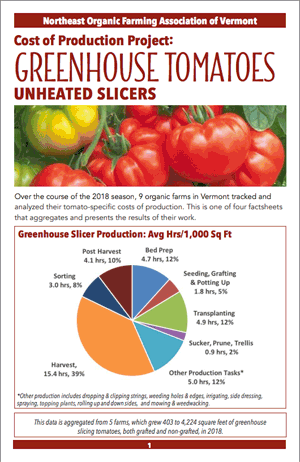
NOFA-VT worked with organic farms in Vermont to track and analyze their greenhouse costs of production, aggregating and presenting the data in a set of factsheets for growers to use, including the cost of production workbook developed as part of the project. NOFA-VT's Cost-of-Production Resources
The Northeast Organic Farming Association of Vermont (NOFA-VT) offers several cost-of-production resources on their website for greenhouse crops, including a summary of metrics, crop-specific analysis, and a cost-of-production workbook. Look for similar resources in your growing region.
As for timing, the broad rule of thumb for a beginning grower in the northern half of the US or Canada is to plant into a greenhouse until February 15, because the low light conditions earlier than that make the crop a riskier venture. More experienced growers and southern growers, however, can often produce all winter. By mid February, many crops can be grown with only minimal heat, and still provide a month or more of earliness compared to field crops.
If you have a market where you can sell vegetables in spring, greenhouse production can be profitable, especially when combined with early field crops. You may, for example, have field-grown spinach ready in April, but realize that's hardly enough to fill a market stand. If you can also bring head lettuce from the heated greenhouse, and arugula, radishes, and carrots from the unheated hoophouse, then you're able to put on a good display. Alternatively, think about the possibilities for Mother's Day: greenhouse tomatoes, cucumbers, cut flowers, and hanging baskets of flowers and fruiting strawberries, in addition to a full range of spring vegetables.
Season extension is just one of the advantages gained from greenhouse growing. Protected crops are less apt to be damaged by wind, rain, and hail so the percentage of marketable products is higher. Yield is often higher as well, if you can provide optimum growing conditions for each crop. Greenhouses protect crops from many diseases, particularly those that are soilborne and splash onto plants in the rain. And greenhouse crops may be protected from common field pests. Of course, greenhouse crops have their own particular problems, such as foliar disease, aphids, and whiteflies, so vigilance is still required.
Tools & Supplies for the Greenhouse

Pruning and vertical trellising for vining crops is essential for making use of valuable greenhouse space.
Greenhouse vegetables, herbs, and flowers can be grown in three main systems:
- In-ground soil culture
- Container culture
- Hydroponics
In either case—unless you're using hydroponics—drip irrigation is recommended to reduce labor, improve watering consistency, and prevent problems caused by overhead watering such as soil splash and wet foliage. Plastic mulch may be used to prevent weeds while also conserving soil moisture. An inner layer of row cover held above growing crops by hoops may be used to keep soil warmer without increasing fuel usage.
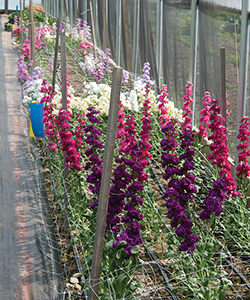
Horizontal trellising helps provide correct spacing, as well as support, for premium cut-flower production.
Tomatoes, cucumbers, peppers, and eggplants require trellising onto vertical lengths of twine. Vines can be attached to the trellis with clips, and Rollerhooks can provide maximal time-saving, space-conserving trellising in a lower-&-lean system. Other greenhouse crops such as basil and cut flowers may need to be held upright with a horizontal trellising system such as Hortonova netting.
For in-ground cultivation of baby leaf greens and salad mix, using a seeder affords greater precision, conserves seed, and speeds up planting greatly. And a greens harvester makes short work of cutting baby lettuces and other greens.
What Crops to Grow in Your Greenhouse, Hoophouse, or Poly Tunnel
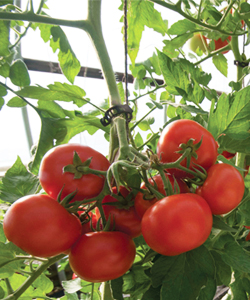
Always in demand and offering the grower a wide range of sizes, shapes, colors, flavors, and production methods, tomatoes are the number-one greenhouse crop in the U.S. Read Our Research Team's Recommendations for Greenhouse Tomatoes…
You can grow virtually anything in a greenhouse, but that protected space is prime real estate—with careful variety choices, you can maximize profits and produce crops that don't do well outside for you. At Johnny's, we breed, trial, and select seed specifically for greenhouse culture. To learn more about what we look for and recommended greenhouse performers, read our article on Greenhouse Trial Criteria.
Vegetable Crops
The most popular crops for greenhouse production tend to be those with high, year-round demand and relatively high ROI, such as:
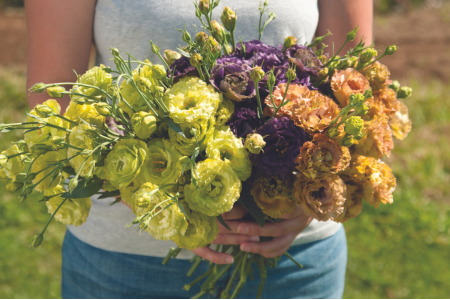
Cut Flower Crops
Cut flowers can also be profitable in a greenhouse. Among seed-grown flowers, the best choices are those that don't do well outside in the wind and rain, such as:
Herbs
Among the herbs, basil can be grown earlier and later in the year in a greenhouse, and there is a consistent demand for it. Tender perennials herbs such as rosemary and thyme can be kept in the greenhouse as mother plants, then propagated in late winter to sell as container plants or culinary cut herbs in spring.
Fruits
Strawberries are another valuable greenhouse crop, and can be grown in hanging containers to keep floor space free for other crops.Whichever crops you choose, variety selection is important for greenhouse success. Varieties are identified as good for greenhouse production for many reasons. They may have increased resistance to common diseases, or grow better in the lower light conditions of the greenhouse. In the case of cucumbers, many greenhouse varieties are parthenocarpic, meaning they don't require insect pollination to set fruit—and gynoecious, meaning all flowers are female, resulting in a higher yield since every flower has the potential to turn into a fruit. Remember to look for the red greenhouse symbol next to variety names here on our website and in our catalogs. To learn more about what we look for and recommended greenhouse performers, read our article on Greenhouse Trial Criteria.
Opening up to Year-round Possibilities
As the days get shorter with the approach of winter and you find yourself indoors more frequently, spend some time reviewing the possibilities for greenhouse or hoophouse production. If you decide to go for it, now is the time to lay out your production plan and schedule purchases and sowing dates. Wherever you live, you could grow a greenhouse full of crops, ready for market through winter and earliest spring!
Learn More About Greenhouse Growing
- Trial Criteria for Johnny's Greenhouse Varieties Article
- Take Our Virtual Greenhouse Tour Video
- Top-Grafting Tomatoes • Advantages, Materials, Technique Tech Sheet (PDF)
- Side-Grafting Tomatoes • Advantages, Materials, Technique Tech Sheet (PDF)
- Trellising Hoophouse Tomatoes Article
- How to Lower & Lean Greenhouse Cukes Video
- Calculating ROI for Greenhouse Cukes Blog
- Cucumber Pruning Video
- Greenhouse Cucumber Production Tech Sheet (PDF)
- Cucumber Types & Terminology (PDF)
- Greenhouse Eggplant Production Tech Sheet (PDF)
- Greenhouse Bell Pepper Production Tech Sheet (PDF)
- Growing Fruit Under Cover Article
- Johnny's Greenhouse Vegetable Varieties Product Listing
- Johnny's Greenhouse Fruit Varieties Product Listing
- Johnny's Greenhouse Flower Varieties Product Listing
- Johnny's Greenhouse Herb Varieties Product Listing
- All Our Greenhouse Performers Product Listing


